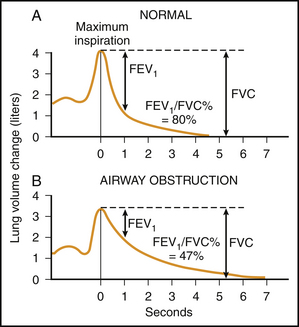32 CASE 32
PHYSICAL EXAMINATION
PE: Patient is wheezing, anxious, and short of breath. The wheezing is more prominent on exhalation, and there is an extended forced expiratory phase. The chest anteroposterior diameter appears large for age and size. The nasal mucosa is edematous, and the pharynx is coated with a clear postnasal discharge. A beta2-adrenergic agent was administered by an inhaler, and the symptoms quickly subsided. The patient’s anxiety was relieved, and heart rate and breathing rate returned to normal. The patient was scheduled for pulmonary function tests.
LABORATORY STUDIES
Spirometry: Normal values. When challenged with methacholine, however, a hyperreactive bronchoconstriction occurred with decreased FEV1, decreased forced vital capacity, and increased residual volume.
PATHOPHYSIOLOGY OF KEY SYMPTOMS
Increased resistance to airflow through the narrowed airways also causes a diminished peak expiratory flow rate. In spirometry, the same effect is indicated by a diminished FEV1. During active exhalation, the increase in pleural pressure is acting to collapse the airways. Consequently, additional respiratory effort does not result in improved exhalation volumes (Fig. 32-1).
< div class='tao-gold-member'>
Only gold members can continue reading. Log In or Register to continue
Stay updated, free articles. Join our Telegram channel

Full access? Get Clinical Tree



